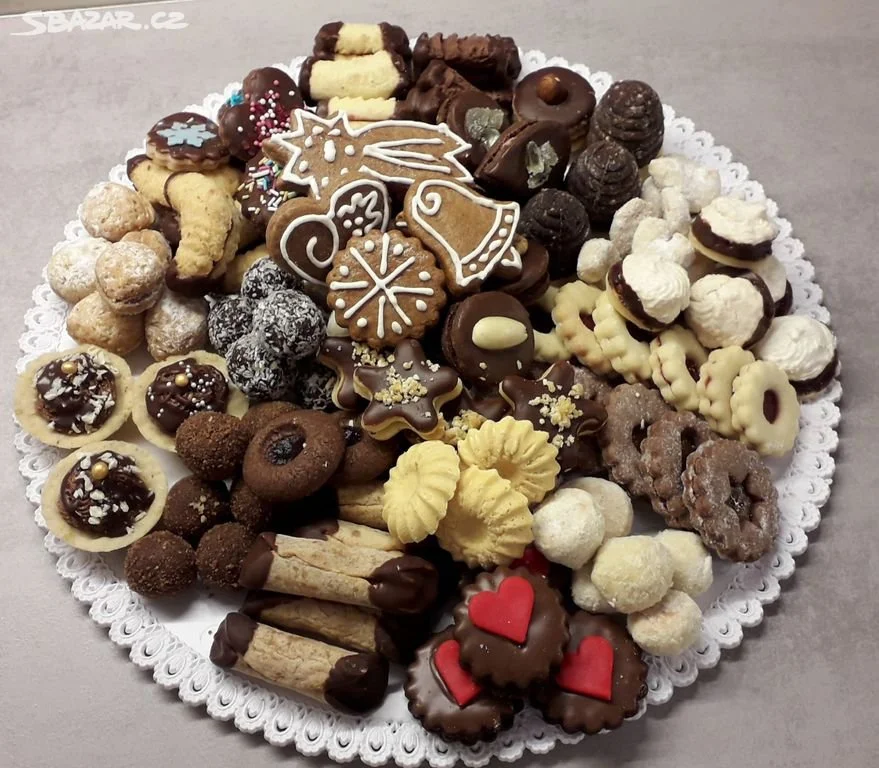Cookie Craze
Czechs have an ardent dedication to cookie making at Christmas. I know that Americans do as well, with our sugar cookies slathered in bright green icing stamped in the shape of Christmas trees or angels. However, the Czech Christmas cookies, heretofore known as “cukrovi,” are a couple steps beyond, as they physically manifest the virtues of dedication and hard work stretched across a long period of time.
Ingredients for the cukrovi may be purchased a few months beforehand, depending on the sales. You can always see when a market knocks a few cents off the price of flour, as the grandmas can be seen exiting the stores with shopping carts laden with dozens of kilos of flour and margarine. It will all be used for cookie making. It is regular for the entire extended family to be involved. A common topic of conversation around this time is ‘how many’ varieties of cookies each family will be committing to. For the robust and dedicated, they will brag of 14 or 15, while the humble families who make only 6 or 7 will need to justify their answer with some excuse about limitations on their commitment this year, and promises to do better in the next one. Tradition dictates that you ought to make 12 varieties to correspond to the 12 months of the year. Some of the recipes are super simplistic, requiring only 3 ingredients, dating to the times of leanness and poverty, while others are painstakingly intricate and ornate. There’s even one dedicated to the wasp nest, an ongoing homage to the hymenoptera family’s significance in these lands.
These cukrovi date back at least to the 1600s, when Czech ancestors believed that the cookies were imbued with protective powers, and thus would be smeared onto fruit trees wished into productivity and crumbled into animal feed. The cukrovi we see today were mostly developed in the early 1900s in wealthy homes. Over time, the designs and recipes became increasingly varied and intricate. Today, each family has their tried and true recipes that are passed down through the generations.
The process for proper production of cukrovi begins in late November. This is because the majority of these cookies require an aging process by which the cookies are softened in the cold. This means that a great many apartment verandas and patios are encumbered with the treats for the advent season. This also serves as a useful tool for assessing each of your neighbors’ commitment to the tradition and their skill in executing it, a sort of cookie accountability system. Thus it also means that the process, if at all possible, will be undertaken at grandma’s garden cottage, away from the prying eyes of judgmental neighbors. It also allows cukrovi to evolve into something analogous to the lauded fishing trip where you caught the 11 pound rainbow trout, but alas, you forgot your camera. No one can doubt your prowess with such a tale, but neither do they wholly believe you when you claim to have produced 50 kilos of 15 varieties. Of course, as times have become more hectic, especially in big cities like Prague, bakeries provide packaged cukrovi in 1kg boxes for those without a month to dedicate to the process. Cukrovi are shared with friends and family well into January, meaning you might receive a box of treats that’s changed hands 7 or 8 times, giving you a breadth of flavors to refine your cukrovi palate.
Nevertheless, there is something endearing about the cukrovi. Receiving them, you are aware of the dedication and labor invested in the gift. Much more interesting than the cookies themselves, which to our American palates are deceptively bland, is the investment of time and attention to detail given in the attempt to perfect them. As Americans we tend to produce as much as possible with the highest level of efficiency, and least amount of investment. Cukrovi are the very antithesis to this approach. A venture into the realm of cukrovi will require full attention and commitment over an extended period of time at the expense of many other possible occupations.
The rigorous standard of Ecclesiastes 9:10 has always hovered over me, demanding that everything I do, I do with all of my might. How can the Christian possibly do every single thing to their absolute best? There’s too much! What could this possibly look like in my daily life? While King Solomon’s admonishment is certainly with merit, it must be taken with the whole counsel of scripture. I find about 40 other places in scripture demanding my full attention and devotion to Christ. Obviously there is a godly balance of occupation of time and allocation of resources, and thus proceeds the application of wisdom. I respect many of the cultural norms here that make Czechs much slower to commit, choose more wisely, and carefully guard one’s margins. In doing so, they are able to more fully devote themselves to those things they take on, and they do them very well.





